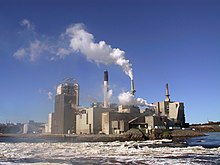This article needs additional citations for verification. (August 2015) |

The environmental impact of paper are significant, which has led to changes in industry and behaviour at both business and personal levels. With the use of modern technology such as the printing press and the highly mechanized harvesting of wood, disposable paper became a relatively cheap commodity, which led to a high level of consumption and waste. The rise in global environmental issues such as air and water pollution, climate change, overflowing landfills and clearcutting have all lead to increased government regulations.[1][2][3] There is now a trend towards sustainability in the pulp and paper industry as it moves to reduce clear cutting, water use, greenhouse gas emissions, fossil fuel consumption and clean up its influence on local water supplies and air pollution.
According to a Canadian citizens' organization, "People need paper products and we need sustainable, environmentally safe production."[4]
Environmental product declarations or product scorecards are available to collect and evaluate the environmental and social performance of paper products, such as the Paper Calculator,[5] Environmental Paper Assessment Tool (EPAT),[6] or Paper Profile.[7]
Both the U.S. and Canada generate interactive maps of environmental indicators which show pollution emissions of individual facilities.[8][9][10]
- ^ Quanz, Meaghan E.; Walker, Tony R.; Oakes, Ken; Willis, Rob (April 2021). "Contaminant characterization in wetland media surrounding a pulp mill industrial effluent treatment facility". Wetlands Ecology and Management. 29 (2): 209–229. doi:10.1007/s11273-020-09779-0. S2CID 234124476.
- ^ Hoffman, Emma; Alimohammadi, Masi; Lyons, James; Davis, Emily; Walker, Tony R.; Lake, Craig B. (September 2019). "Characterization and spatial distribution of organic-contaminated sediment derived from historical industrial effluents". Environmental Monitoring and Assessment. 191 (9): 590. doi:10.1007/s10661-019-7763-y. PMID 31444645. S2CID 201283047.
- ^ Hoffman, Emma; Bernier, Meagan; Blotnicky, Brenden; Golden, Peter G.; Janes, Jeffrey; Kader, Allison; Kovacs-Da Costa, Rachel; Pettipas, Shauna; Vermeulen, Sarah; Walker, Tony R. (December 2015). "Assessment of public perception and environmental compliance at a pulp and paper facility: a Canadian case study". Environmental Monitoring and Assessment. 187 (12): 766. doi:10.1007/s10661-015-4985-5. PMID 26590146. S2CID 3432051.
- ^ "Clean Air - Clean Water - Pulp Info Centre". Reach for Unbleached Foundation, Comox, BC. Archived from the original on 2006-01-01. Retrieved 2008-05-07.
- ^ "Paper Calculator". Environmental Paper Network Paper Calculator. July 30, 2019.
- ^ "EPAT - Welcome". Epat.org. Retrieved 16 August 2018.
- ^ Paper Profile, 2008. Manual for an environmental product declaration for the pulp and paper industry – Paper Profile, Valid from January 2008
- ^ EPA,OEI,OIAA,TRIPD, US (2015-07-16). "TRI National Analysis - US EPA". US EPA. Retrieved 16 August 2018.
{{cite web}}: CS1 maint: multiple names: authors list (link) - ^ "Interactive environmental indicators maps". 2010-09-16. Retrieved 31 July 2019.
- ^ Dionne, Joelle; Walker, Tony R. (1 December 2021). "Air pollution impacts from a pulp and paper mill facility located in adjacent communities, Edmundston, New Brunswick, Canada and Madawaska, Maine, United States". Environmental Challenges. 5: 100245. Bibcode:2021EnvCh...500245D. doi:10.1016/j.envc.2021.100245.